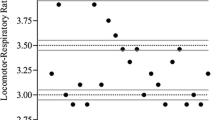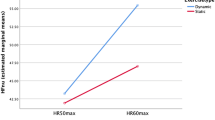Abstract
Purpose
Pedalling cadence influences respiratory frequency (fR) during exercise, with group III/IV muscle afferents possibly mediating its effect. However, it is unclear how exercise intensity affects the link between cadence and fR. We aimed to test the hypothesis that the effect of cadence on fR is moderated by exercise intensity, with interest in the underlying mechanisms.
Methods
Ten male cyclists performed a preliminary ramp incremental test and three sinusoidal experimental tests on separate visits. The experimental tests consisted of 16 min of sinusoidal variations in cadence between 115 and 55 rpm (sinusoidal period of 4 min) performed during passive exercise (PE), moderate exercise (ME) and heavy exercise (HE). The amplitude (A) and phase lag (φ) of the dependent variables were calculated.
Results
During PE, fR changed in proportion to variations in cadence (r = 0.85, P < 0.001; A = 3.9 ± 1.4 breaths·min−1; φ = − 5.3 ± 13.9 degrees). Conversely, the effect of cadence on fR was reduced during ME (r = 0.73, P < 0.001; A = 2.6 ± 1.3 breaths·min−1; φ = − 25.4 ± 26.3 degrees) and even more reduced during HE (r = 0.26, P < 0.001; A = 1.8 ± 1.0 breaths·min−1; φ = − 70.1 ± 44.5 degrees). No entrainment was found in any of the sinusoidal tests.
Conclusion
The effect of pedalling cadence on fR is moderated by exercise intensity—it decreases with the increase in work rate—and seems to be mediated primarily by group III/IV muscle afferents, at least during passive exercise.





Similar content being viewed by others
Availability of data and material
The data sets generated during and/or analysed during the current study are available from the corresponding author on reasonable request.
Code availability
Not applicable.
Abbreviations
- A:
-
Amplitude
- ANOVA:
-
Analysis of variance
- EMG:
-
Electromyography
- f R :
-
Respiratory frequency
- HE:
-
Heavy exercise
- HR:
-
Heart rate
- Hz:
-
Hertz
- ME:
-
Moderate exercise
- PCO2 :
-
Pressure of carbon dioxide
- PE:
-
Passive exercise
- PETCO 2 :
-
End-tidal partial pressure of carbon dioxide
- PPO:
-
Peak power output
- RMS:
-
Root mean square
- RPE:
-
Rating of perceived exertion
- Rpm:
-
Revolutions per minute
- \({\dot{\text{V}}\text{CO}}_{2}\) :
-
Carbon dioxide output
- \({\dot{\text{V}}}_{{\text{E}}}\) :
-
Minute ventilation
- \({\dot{\text{V}}\text{O}}_{2}\) :
-
Oxygen uptake
- \({\dot{\text{V}}\text{O}}_{{2{\text{peak}}}}\) :
-
Peak value of oxygen uptake
- VT :
-
Tidal volume
- VT1:
-
First ventilatory threshold
- VT2:
-
Second ventilatory threshold
- φ:
-
Phase lag
References
Amann M, Blain GM, Proctor LT, Sebranek JJ, Pegelow DF, Dempsey JA (2010) Group III and IV muscle afferents contribute to ventilatory and cardiovascular response to rhythmic exercise in humans. J Appl Physiol 109:966–976. https://doi.org/10.1152/japplphysiol.00462.2010
Bakker HK, Struikenkamp RS, De Vries GA (1980) Dynamics of ventilation, heart rate, and gas exchange: sinusoidal and impulse work loads in man. J Appl Physiol 48:289–301. https://doi.org/10.1152/jappl.1980.48.2.289
Beaver WL, Wasserman K, Whipp BJ (1986) A new method for detecting anaerobic threshold by gas exchange. J Appl Physiol 60:2020–2027. https://doi.org/10.1152/jappl.1986.60.6.2020
Bechbache RR, Duffin J (1977) The entrainment of breathing frequency by exercise rhythm. J Physiol 272:553–561. https://doi.org/10.1113/jphysiol.1977.sp012059
Bell HJ, Duffin J (2003) CO2 does not affect passive exercise ventilatory decline. J Appl Physiol 95:322–329. https://doi.org/10.1152/japplphysiol.01176.2002
Bell HJ, Ramsaroop DM, Duffin J (2003) The respiratory effects of two modes of passive exercise. Eur J Appl Physiol 88:544–552. https://doi.org/10.1007/s00421-002-0771-5
Bernasconi P, Kohl J (1993) Analysis of co-ordination between breathing and exercise rhythms in man. J Physiol 471:693–706. https://doi.org/10.1113/jphysiol.1993.sp019923
Berry MJ, Puntenney PJ, Sandt LA (1989) Ventilatory responses during varied stride and pedal frequencies. Respir Physiol 78:219–228. https://doi.org/10.1016/0034-5687(89)90054-6
Bland JM, Altman DG (1995) Statistics notes: Calculating correlation coefficients with repeated observations: Part 1–correlation within subjects. BMJ 310:446–446. https://doi.org/10.1136/bmj.310.6977.446
Borg G (1998) Borg’s perceived exertion and pain scales. Human Kinetics, Champaign, IL, USA
Bramble D, Carrier D (1983) Running and breathing in mammals. Science 219:251–256. https://doi.org/10.1126/science.6849136
Bruce RM, Jolley C, White MJ (2019) Control of exercise hyperpnoea: contributions from thin-fibre skeletal muscle afferents. Exp Physiol 104:1605–1621. https://doi.org/10.1113/EP087649
Casaburi R, Whipp BJ, Wasserman K, Beaver WL, Koyal SN (1977) Ventilatory and gas exchange dynamics in response to sinusoidal work. J Appl Physiol 42:300–301. https://doi.org/10.1152/jappl.1977.42.2.300
Casaburi R, Whipp BJ, Wasserman K, Koyal SN (1978) Ventilatory and gas exchange responses to cycling with sinusoidally varying pedal rate. J Appl Physiol 44:97–103. https://doi.org/10.1152/jappl.1978.44.1.97
Caterini JE, Duffin J, Wells GD (2016) Limb movement frequency is a significant modulator of the ventilatory response during submaximal cycling exercise in humans. Respir Physiol Neurobiol 220:10–16. https://doi.org/10.1016/j.resp.2015.09.004
Cohen J (2013) Statistical power analysis for the behavioral sciences, 2nd edn. L. Erlbaum Associates, Hillsdale, NJ, USA
de Morree HM, Klein C, Marcora SM (2014) Cortical substrates of the effects of caffeine and time-on-task on perception of effort. J Appl Physiol 117:1514–1523. https://doi.org/10.1152/japplphysiol.00898.2013
Farina D, Macaluso A, Ferguson RA, De Vito G (2004) Effect of power, pedal rate, and force on average muscle fiber conduction velocity during cycling. J Appl Physiol 97:2035–2041. https://doi.org/10.1152/japplphysiol.00606.2004
Forster HV, Haouzi P, Dempsey JA (2012) Control of breathing during exercise. Compr Physiol 2:743–777. https://doi.org/10.1002/cphy.c100045
Fregosi RF (1991) Short-term potentiation of breathing in humans. J Appl Physiol 71:892–899. https://doi.org/10.1152/jappl.1991.71.3.892
Gozal D, Simakajornboon N (2000) Passive motion of the extremities modifies alveolar ventilation during sleep in patients with congenital central hypoventilation syndrome. Am J Respir Crit Care Med 162:1747–1751. https://doi.org/10.1164/ajrccm.162.5.2005012
Gravier G, Delliaux S, Delpierre S, Guieu R, Jammes Y (2013) Inter-individual differences in breathing pattern at high levels of incremental cycling exercise in healthy subjects. Resp Physiol Neurobiol 189:59–66. https://doi.org/10.1016/j.resp.2013.06.027
Green AL, Wang S, Purvis S et al (2007) Identifying cardiorespiratory neurocircuitry involved in central command during exercise in humans. J Physiol 578:605–612. https://doi.org/10.1113/jphysiol.2006.122549
Haouzi P, Bell HJ (2009) Control of breathing and volitional respiratory rhythm in humans. J Appl Physiol 106:904–910. https://doi.org/10.1152/japplphysiol.90675.2008
Haouzi P, Chenuel B, Huszczuk A (2004) Sensing vascular distension in skeletal muscle by slow conducting afferent fibers: neurophysiological basis and implication for respiratory control. J Appl Physiol 96:407–418. https://doi.org/10.1152/japplphysiol.00597.2003
Holwerda SW, Vianna LC (2019) Interaction between the muscle metaboreflex and central command–A clearer picture of cardiorespiratory control during exercise. Exp Physiol 104:1441–1442. https://doi.org/10.1113/EP087939
Jasinskas C, Wilson B, Hoare J (1980) Entrainment of breathing rate to movement frequency during work at two intensities. Respir Physiol 42:199–209. https://doi.org/10.1016/0034-5687(80)90115-2
Jastrzębska AD, Kowalski M (2015) Effect of cadence on respiratory response during unloaded cycling in healthy individuals. Hum Mov 16:36–41. https://doi.org/10.1515/humo-2015-0025
Lam E, Greenhough E, Nazari P, White MJ, Bruce RM (2019) Muscle metaboreflex activation increases ventilation and heart rate during dynamic exercise in humans. Exp Physiol 104:1472–1481. https://doi.org/10.1113/EP087726
Lamarra N, Whipp BJ, Ward SA, Wasserman K (1987) Effect of interbreath fluctuations on characterizing exercise gas exchange kinetics. J Appl Physiol 62:2003–2012. https://doi.org/10.1152/jappl.1987.62.5.2003
Lucía A, Carvajal A, Calderón FJ, Alfonso A, Chicharro JL (1999) Breathing pattern in highly competitive cyclists during incremental exercise. Eur J Appl Physiol 79:512–521. https://doi.org/10.1007/s004210050546
Ludyga S, Gronwald T, Hottenrott K (2016) Effects of high vs. low cadence training on cyclists’ brain cortical activity during exercise. J Sci Med Sport 19:342–347. https://doi.org/10.1016/j.jsams.2015.04.003
McCloskey DI, Mitchell JH (1972) Reflex cardiovascular and respiratory responses originating in exercising muscle. J Physiol 224:173–186. https://doi.org/10.1113/jphysiol.1972.sp009887
Mitchell RA, Boyle KG, Ramsook AH, Puyat JH, Henderson WR, Koehle MS, Guenette JA (2019) The impact of cycling cadence on respiratory and hemodynamic responses to exercise. Med Sci Sport Exerc 51:1727–1735. https://doi.org/10.1249/MSS.0000000000001960
Nicolò A, Sacchetti M, Marcora SM (2015) Are respiratory frequency and tidal volume regulated by different inputs during exercise? J Appl Physiol 118:1559. https://doi.org/10.1152/japplphysiol.00229.2015
Nicolò A, Girardi M, Bazzucchi I, Felici F, Sacchetti M (2018) Respiratory frequency and tidal volume during exercise: differential control and unbalanced interdependence. Physiol Rep 6:e13908. https://doi.org/10.14814/phy2.13908
Nicolò A, Girardi M, Sacchetti M (2017a) Control of the depth and rate of breathing: metabolic vs. non-metabolic inputs. J Physiol 595:6363–6364. https://doi.org/10.1113/JP275013
Nicolò A, Marcora SM, Bazzucchi I, Sacchetti M (2017b) Differential control of respiratory frequency and tidal volume during high-intensity interval training. Exp Physiol 102:934–949. https://doi.org/10.1113/EP086352
Nicolò A, Massaroni C, Passfield L (2017c) Respiratory frequency during exercise: the neglected physiological measure. Front Physiol 8:922. https://doi.org/10.3389/fphys.2017.00922
Nicolò A, Marcora SM, Sacchetti M (2016) Respiratory frequency is strongly associated with perceived exertion during time trials of different duration. J Sports Sci 34:1199–1206. https://doi.org/10.1080/02640414.2015.1102315
Nicolò A, Marcora SM, Sacchetti M (2020) Time to reconsider how ventilation is regulated above the respiratory compensation point during incremental exercise. J Appl Physiol 128:1447–1449. https://doi.org/10.1152/japplphysiol.00814.2019
Nicolò A, Sacchetti M (2019) A new model of ventilatory control during exercise. Exp Physiol 104:1331–1332. https://doi.org/10.1113/EP087937
Olson AL, Zwillich C (2005) The obesity hypoventilation syndrome. Am J Med 118:948–956. https://doi.org/10.1016/j.amjmed.2005.03.042
Paterson DJ, Wood GA, Morton AR, Henstridge JD (1986) The entrainment of ventilation frequency to exercise rhythm. Eur J Appl Physiol Occup Physiol 55:530–537. https://doi.org/10.1007/BF00421649
Potts JT, Rybak IA, Paton JFR (2005) Respiratory rhythm entrainment by somatic afferent stimulation. J Neurosci 25:1965–1978. https://doi.org/10.1523/JNEUROSCI.3881-04.2005
Rådegran G, Saltin B (1998) Muscle blood f low at onset of dynamic exercise in humans. Am J Physiol Circ Physiol 274:H314–H322. https://doi.org/10.1152/ajpheart.1998.274.1.H314
Saltin B, Rådegran G, Koskolou MD, Roach RC (1998) Skeletal muscle blood flow in humans and its regulation during exercise. Acta Physiol Scand 162:421–436. https://doi.org/10.1046/j.1365-201X.1998.0293e.x
Sato K, Matsuo H, Katayama K, Ishida K, Honda Y, Katsumata K, Miyamura M (2004) Ventilatory and circulatory responses at the onset of voluntary exercise and passive movement in sprinters. Eur J Appl Physiol 92:196–203. https://doi.org/10.1007/s00421-004-1075-8
Thornton JM, Guz A, Murphy K, Griffith AR, Pedersen DL, Kardos A, Leff A, Adams L, Casadei B, Paterson DJ (2001) Identification of higher brain centres that may encode the cardiorespiratory response to exercise in humans. J Physiol 533:823–836. https://doi.org/10.1111/j.1469-7793.2001.00823.x
Tipton MJ, Harper A, Paton JFR, Costello JT (2017) The human ventilatory response to stress: rate or depth? J Physiol 595:5729–5752. https://doi.org/10.1113/JP274596
Wigertz O (1970) Dynamics of ventilation and heart rate in response to sinusoidal work load in man. J Appl Physiol 29:208–218. https://doi.org/10.1152/jappl.1970.29.2.208
Zenon A, Sidibe M, Olivier E (2015) Disrupting the supplementary motor area makes physical effort appear less effortful. J Neurosci 35:8737–8744. https://doi.org/10.1523/JNEUROSCI.3789-14.2015
Funding
The present study was supported by the University of Rome “Foro Italico” (CDR2.BANDO2017SM).
Author information
Authors and Affiliations
Contributions
Conception or design of the work: M.G., A.N., and M.S. Acquisition, analysis or interpretation of data for the work: M.G., A.N., I.B., F.F. and M.S. Drafting the work or revising it critically for important intellectual content: M.G., A.N., I.B., F.F. and M.S. All authors approved the final version of the manuscript and agree to be accountable for all aspects of the work in ensuring that questions related to the accuracy or integrity of any part of the work are appropriately investigated and resolved. All persons designated as authors qualify for authorship, and all those who qualify for authorship are listed.
Corresponding author
Ethics declarations
Conflict of interest
The authors declare that they have no conflict of interest.
Ethical approval
All procedures performed in this study were in accordance with the ethical standards of the institutional and/or national research committee (Ethics Committee of the University of Rome Sapienza) and with the 1964 Helsinki declaration and its later amendments or comparable ethical standards.
Informed consent
Informed consent was obtained from all individual participants included in the study.
Additional information
Communicated by Guido Ferretti.
Publisher's Note
Springer Nature remains neutral with regard to jurisdictional claims in published maps and institutional affiliations.
Rights and permissions
About this article
Cite this article
Girardi, M., Nicolò, A., Bazzucchi, I. et al. The effect of pedalling cadence on respiratory frequency: passive vs. active exercise of different intensities. Eur J Appl Physiol 121, 583–596 (2021). https://doi.org/10.1007/s00421-020-04533-z
Received:
Accepted:
Published:
Issue Date:
DOI: https://doi.org/10.1007/s00421-020-04533-z




